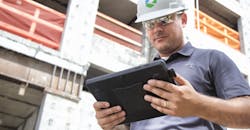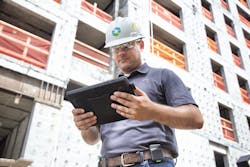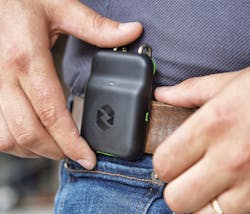Each year, the gear construction and maintenance workers pack into the field, grows more advanced. Web-connected mobile devices, personal protective equipment (PPE), smart tools, and even augmented reality headsets and drones are giving workers the means to perform their jobs more efficiently, boosting productivity and reducing errors in the process.
Now, technology is opening another new front in this fast-evolving arena, in an even more intimate way. It’s worker personal safety, a chronic source of concern for employers because of the multiple and steep human and financial costs that on-the-job injuries and fatalities continue to levy.
Despite decades of efforts to improve it, workplace safety, especially in the construction and maintenance sector, remains a problem. The Occupational Health & Safety Administration (OSHA) says 20% of all work-related fatalities and injuries in the United States happen on construction job sites. Those numbers haven’t escaped the notice of innovators keen to fix costly, intractable problems with breakthrough solutions, and construction-related safety is a prime example.
A notable result is the nascent field of sensor-based and network-connected wearable technology. A true Internet of Things (IoT) application, wearables with embedded monitoring and communication capabilities open the door to real-time, on-the-job oversight of worker movements and practices; enhanced detection of environmental hazards; improved response time and alert capabilities; and collection of hard-to capture data on overall job-site safety conditions.
Capable of being incorporated into anything that can be put on the body — from hardhats, boots, and vests to wristbands, clip-ons, and headsets — the technology is designed to both protect workers and give those who send them into the field access to potentially actionable information that’s long been nearly impossible to collect.
In one application drawing interest, workers can be tracked as they traverse a job site, and their micro body movements can also be detected, alerting overseers to those who have sustained injuries may be performing tasks in an unsafe fashion or are in potentially unsafe areas. By knowing where workers are — and how they’re performing their duties — there’s potential to both forestall injuries and more quickly come to the aid of those who’ve sustained an injury.
In other scenarios, sensors in wearables can serve to keep workers out of harm’s way by signaling the presence of toxic substances, proximity to moving equipment, job-site evacuation orders and emergencies, electrical dangers, and even changes in body vital signs, such as a rising core temperature or heart rate.
Silent protection
The beauty of the wearables concept is that all this functionality operates unobtrusively in the background, requiring little or no interaction from workers. In the best applications, workers can perform their jobs unimpeded, but now, with a degree of insulation from multiple job-site dangers, that’s been hard to attain. But as it’s deployed, wearable technology might encounter some hurdles — one being concern about “Big Brother;” workers and even employers might have reservations about the privacy downsides of ratcheting up personnel tracking and monitoring.
Yet those worries are likely to be trumped by the desire to move the needle more aggressively on workplace safety, and even more so by the ability to use breakthroughs like wearables that make big leaps in functionality, deployability, and tangible results possible.
Randy Barnett, an electrical safety consultant with NTT Training, Centennial, Colo., is seeing more wearables cropping up in industries he advises and views them as having features that, over time, could produce a noticeable impact on job-site safety.
“We’re seeing it in the oil and gas industries where workers are often in remote locations or working alone in refineries or industrial facilities,” he says. “And they’ve come up in discussions about how to better detect gases that workers may encounter, using products like H2 gas detectors in a wearable.”
Functionalities that include worker location monitoring; detection of incapacitating falls; real-time alerts; and monitoring for signs of heat exhaustion are particularly intriguing, Barnett says, and are examples of where the wearable format is a key factor. But wearables don’t come without challenges, he notes. One is that some types could pose a problem for electrical workers.
“A drawback is whether it’s safe or not to wear some types of devices when you’re within a limited approach boundary where you’re subject to electrical shock,” he says. “You want to be careful you’re not in a location where this technology could be a potential source of injury.”
That and other concerns that often accompany new technology could prove legitimate. But for now, wearables may be stirring more curiosity and excitement than worries among employers coping with the challenges of managing the safety of large workforces on big job sites.
Belway Electrical Contracting Corp., Elmsford, N.Y., recently got its first exposure to safety-oriented wearable technology as a subcontractor on a luxury residential high-rise project in New Rochelle, N.Y. The construction manager, John Moriarty & Associates, informed Belway and other subs that all workers would be wearing clip-on tracking devices that monitor location, receive and send alerts, and are programmed to sense abrupt body movements indicative of a fall or other mishap. There was some initial hesitation about the devices, says Belway Electrical Foreman Ryan Reynolds, but that gave way to more clarity that they might produce a safer job site.
“Safety is a big thing for our company, so I like these trackers,” he says. “We have technology now to track a lot of things on jobs, so this could be just as beneficial if we’re able to use a dashboard to see where our workforce is and what they’re doing. We do a lot of work with apprentices, and sometimes they can be overly curious and get into areas they shouldn’t be in; if they find their way into a high-voltage electrical closet, I want to know and get them out.”
Reynolds sees the devices as part of a larger push to leverage advanced sensor and communications technology to better manage construction jobs. The company has had experience using cruder tracking and sensor technology, such as hard-hat bar codes for job-site “population control” and materials tracking digital apps he says, but the new clip-on sensors take functionality in an important new direction. They haven’t factored into a real safety event yet on the project, he notes, but they appear to work as billed.
“I could see this taking off the way safety protocols are being enforced these days,” Reynolds says.
On-site monitoring
That’s the essential calculation behind the tracking product Belway is using, the Spot-r Clip, developed by Triax Technologies. Aware of the construction industry’s desire to take new tacks in addressing worker safety and its need to embrace technology more purposefully, the Norwalk, Conn., company designed its product to address the core building blocks of improving worker safety: real-time monitoring, generating actionable data, and shortening response times.
The tracking device works on a concept analogous to Wi-Fi, allowing connectivity, collection, and communication of sensor data as well as instant messaging. With a worksite network established, and the nodes being the workers, says Triax founder and CEO Chad Hollingsworth, companies working the site gain both a macro and micro view of what the workforce is doing and the real-time status of individuals. The result is visibility, information, and control — three keys to safety.
“We’re focusing on a few main safety features, an automated alert for detected falls, instant alerts for safety personnel on the site and a push-button call for help,” he says. “Companies using the product have already seen some behavior changes based on notifications of workers jumping into pits instead of using ladders, and jumping off equipment. And it’s been shown to reduce site evacuation times by 74%.”
Information generated through the product is important in real time, but its real value may lie in developing insights that can lead to permanent corrective action. The corporate director of safety for Gilbane Building Co., a Providence, R.I.-based construction management firm, says trials it conducted with the tracking device last year contributed to a noticeable change in safety culture. After mishaps or safety violations were exposed, workers were counseled on safe procedures.
“The opportunity to identify unsafe actions and then educate workers immediately is one of the biggest advantages,” Severson says. “The more people get used to using the technology, we will see fewer and fewer instances of unsafe behaviors.”
Hazard detection
In some workplace safety scenarios, however, moving the needle over time on behaviors is secondary to immediate prevention, and that’s where some wearable devices could provide value.
That’s the case with a wearable concept that could be moving closer to commercialization — a wristband that alerts the wearer to the presence of potentially dangerous electrical voltage. Now in field testing, the Proxxi uses a digital sensor that can be programmed to provide escalating vibration and audible alerts as a pre-determined safe distance to energized equipment is broached. There’s also an associated app in development that would provide more detail about the nature of the potential danger. The band also can detect a fall that might be indicative of a shock incident and send an alert that could speed critical response time.
Proxxi CEO Campbell Macdonald characterizes the device as a valuable safety backstop for those who work with or around electricity. Employees of electric utilities, construction workers of all types, service contractors, and first responders are primary candidates to use the wearable, which was being evaluated by potential customers as of mid-April. He says it’s targeted to companies whose field workers are at varying degrees of risk from dangerous voltage, depending on their level of qualification and preparation to be near energized equipment.
“Most workers, even those who are qualified to work around high voltage, shouldn’t be doing much work with energized equipment,” Macdonald says. “Normally, if the proper steps are followed, no one gets hurt. But the trouble is human error, and that’s a leading cause of electrical injuries. We think this product helps close that gap.”
In addition to offering ongoing front-line protection to workers, the product, Macdonald says, also has a data collection component that could give companies key insights into risk and safety practices. By logging and recording instances of voltage encounters and the details; information on the frequency of dangerous practices; specific areas of concern; and near misses, which are commonplace and highly valuable to understand, an analyzable database can be formulated.
“The vast majority of near misses go unreported, often intentionally because they don’t want to be written up, and sometimes people don’t even realize they’ve had one,” he says. “So, there’s a poor data set on what’s reported versus what’s actually happening.”
Armed with information on near misses; which workers may be more at risk; and what parts of the environment may pose correctable risk, companies can gain insights that can lead to course corrections on safety on various fronts, Macdonald suggests.
“Smaller organizations may see the value in the protection the band offers, while some of the larger ones managing large teams of workers will see additional value in the data,” he says.
Electrical contractors might be among the eventual target audiences for the device, but at least one isn’t so sure of its ultimate value in that line of work. Reid Romer, safety director for Egan Co., a Brooklyn Park, Minn., contractor, says standard NFPA 70E procedures in place for voltage checking using a voltage tester or other means are usually sufficient if followed. It might serve a purpose as a backup check, but he doesn’t see it as a replacement for established protocols.
“If we’re to evaluate something like this for the work we do, we’d ask how different it is from handheld voltage testers,” he says. “And how could we be sure that it doesn’t produce any errors?”
One possible application, Romer says, would be incursions by other trades into potentially dangerous areas of job sites. Quickly and easily alerting non-electrical workers to imminent danger in the EC’s domain with a simple wearable would be clearly desirable.
Yet Romer is intrigued by the concept of wearables, but more so by the idea of using sensors and other technology to alert and keep workers away from dangers. Egan has had some exposure to the use of gas/noise monitors on job sites, and is also seeing rising interest in radio frequency monitors that can warn of levels that might expose workers to unsafe levels of radiation.
Egan has had little to no experience with wearables to date, but Romer says some applications look interesting. One is a wearable alert linked to intrusion detection systems used in road projects. If a fast-moving or out-of-control vehicle is detected in a work zone, workers in imminent danger could be warned and take cover. That’s the kind of practical application, Romer says, that makes wearables a trend worth watching.
Zind is a freelance writer based in Lees Summit, Mo. He can be reached at [email protected].
Sidebar: Wearables and Awareness: Attacking Injuries by Improving Worker Focus
Inattention, surprises, and confusion can be a root cause of job-related injuries to construction and maintenance workers. Fix that ― make workers better and more readily informed about their environment, and more focused and aware ― and occupational injury rates could come down.
Wearable technology incorporating sensors and alerts holds promise for mitigating the consequences of distracted workers, alerting them to danger, and speeding response to injuries. But wearables are also emerging that could help give workers some immunity to injuries.
The solution could lie partly in head-worn devices that put detailed and essential information about a job site, project, or task not at their fingertips, but even better, in their field of vision. Hands-free, heads-up access to blueprints, building information modeling (BIM) data, operations manuals, and even enhanced augmented or virtual reality (AR/VR) project views could not only help improve job quality and efficiency, but also translate to more hyper-aware and engaged workers better protected from unseen or unheeded job-site dangers.
Last year, Ferry Electric Co., a Pittsburgh-based electrical contractor, tested a wearable computer marketed by RealWear, Vancouver, Wash. The display-equipped headset that affixes to a hard-hat transmitted project details normally accessed via a handheld mobile device, paper documents, or voice calls.
“What’s great is that it gives the man in the field instant information and communication that can be accessed hands-free,” says owner Jim Ferry. “In our industry, we’re used to working, picking up drawings, phoning, opening catalogs and spec books, going back to work, and repeating that cycle. Now we can keep on working and have procedures for things like lockout/tagout clearly and readily displayed.”
A byproduct of that, he says, might be fewer attention-sapping disruptions. That could help improve productivity and reduce errors, but another benefit could be reduced on-the-job injuries.
Other types of technology aided head-worn gear now being tested, such as the Daqri Smart Glasses, could increase workers’ margin of safety by providing AR-enhanced views of work spaces, showing components of projects under construction that may be hidden from view and potentially dangerous if encountered. When employed in the design stages, both AR and close cousin VR, can help designers construct projects that end up being easier and safer for workers to build by sidestepping potential design conflicts.
Technology-aided design, in fact, could become a larger determinant of the safety environment for construction and maintenance workers. Reid Romer, safety director for Egan Co., a Brooklyn Park, Minn., contractor, says advances in 3D modeling and BIM tools help architects and engineers create designs that produce better sequencing of installation.
“Where safety risk often increases on jobs is with all the work that can be going on at the same time, or where you need to get around other parts of the project to do your work,” he says. “Modeling can help identify potential conflicts.”
About the Author
Tom Zind
Freelance Writer
Zind is a freelance writer based in Lee’s Summit, Mo. He can be reached at [email protected].



